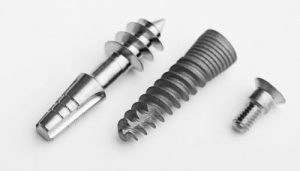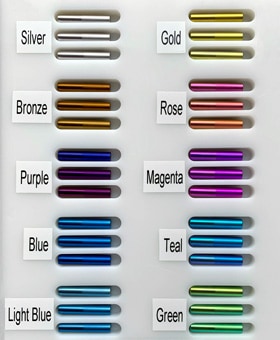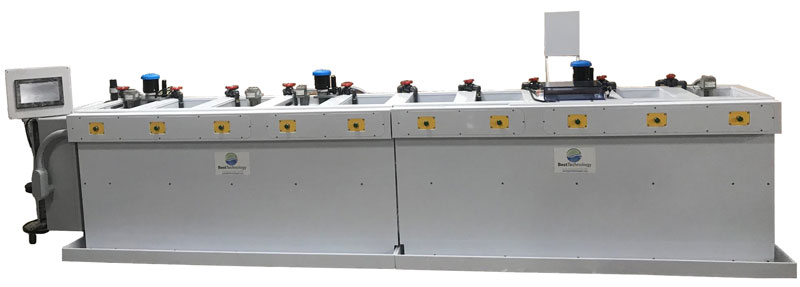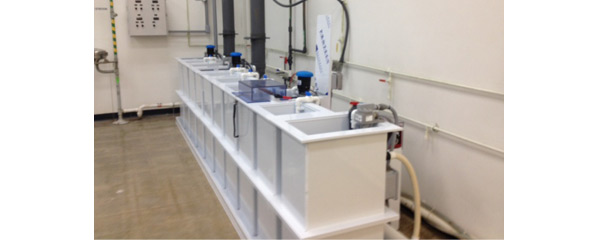Which Titanium Alloy Is For Coloring Anodising
- Types
- How Anodizing Works
- Process Steps
Titanium anodizing is an electrolytic finishing process that manipulates the oxide layer on the surface of titanium via electric current. The titanium item forms the anode (positive electrode) of an electrolytic jail cell; hence the name "anodize."
Anodizing has a long history in the aerospace industry, where information technology was get-go used in 1923 to protect British seaplane parts from common salt-water corrosion. Aerospace companies proceed to apply anodizing processes today to protect metals from furnishings of aging, clothing and corrosion.
The medical device industry also widely uses the titanium anodizing process, since anodized titanium parts are nontoxic and suitable for biomedical applications, such as orthopedic implants.
Video: Titanium Anodizer Organisation

Types of Titanium Anodizing
At that place are two commonly used types of titanium anodizing: Type 2 and Type 3. Type 1 is far less common, and is used in specialized high-temperature treatments.
Type 2 Anodized Titanium
Type 2 is mainly for wear purposes: Information technology protects the metal surface against the effects of clothing. When untreated titanium parts rub confronting each other, they produce titanium dust – a result that is not desirable with orthopedic implants, for example. Blazon 2 anodizing provides a wear-resistant surface and helps preclude seizing or friction between sliding titanium surfaces.
The reduced friction, or lubricity, from Type ii anodized titanium besides helps patients with orthopedic implants by improving mobility of joints.
For virtually Type 2 titanium anodizing lines, AMS 2488 is the applicable specification. SAE International, the aerospace standards organization, is the governing authority for the specification for Type ii, which was terminal revised in 2019.
For aerospace applications, Type 2 anodized parts are uniform with aircraft fluids and tin withstand extreme temperatures within a range of -70 °F to 260 °F. Blazon two anodized titanium resists corrosion from exposure to salt water and humidity.
Blazon two anodized titanium parts are a distinctive gray color. This makes them hands distinguished from stainless steel, or from colour anodized titanium.

In this photo of dental implant hardware, the middle screw has a Blazon ii anodized titanium terminate.
Type 3 Titanium Anodizing – Colour Titanium
Blazon 3 titanium anodizing is also called titanium color anodizing. Type 3 colour anodizing is widely used in the medical earth for quick visual identification of parts. For example, an orthopedic surgeon in mid-process can merely ask for a blue bone screw, without having to specify the 12 mm length of the screw.

Some other example of colour coding to assist doctors and physicians is bone fixation plates that an orthopedic surgeon uses to treat trauma fractures. These bone fixation plates have drill guides of dissimilar colors to bespeak the anatomical departure between the left and correct plates.
Type three titanium color anodizing is less common in the aerospace industry, but sometimes is used for quick visual identification in complicated assemblies.
Exterior the medical device and aerospace industries, Blazon 3 colored titanium is also used in jewelry manufacturing.
Titanium Color Nautical chart

In contrast to Type 2, Type 3 titanium color anodizing lacks an overarching industry specification. AMS 2488 does not address colour anodizing, and no industry-broad standards exist to define specific colors in the Blazon 3 spectrum. This makes color matching of parts from one batch to another a real challenge.
The lack of standards for Blazon 3 titanium color anodizing means that manufacturers must build their own process validation from the ground up, rather than starting with the framework offered past an industry specification. Best Technology'due south process equipment experts offer process validation consulting services for manufacturers installing a new Blazon iii titanium anodizing line.
Fundamental differences betwixt Blazon 2 and Type 3 Titanium Anodizing
Blazon 2 differs significantly from Type 3 titanium anodizing.
| Type 2 | Type three | |
| Primary Benefit | Avert friction between metal surfaces | Provide quick visual identification of parts |
| Specification | AMS 2488 | None defined |
| Biocompatible for medical device implants | Yep | Yes |
| Improved wear resistance | Yes | No |
| Anti-galling / increased lubricity | Aye | Some |
| Color | Grey | Diversity of colors. Typical range includes:
|
Anodizing Equipment and Tanks for Titanium Color Anodize

How does anodizing work with titanium?
Anodizing is an electrochemical process that uses both electricity and chemistry to manipulate the oxide layer of titanium. The titanium part, serving equally the anode (positive electrode), is immersed in an aqueous electrolyte solution such every bit trisodium phosphate (TSP) or various salts. When electrical current is practical, water molecules undergo hydrolysis and split up into hydrogen and oxygen. The electrical potential forces the oxygen to the titanium surface, adding to the sparse layer of titanium oxide. The last perceived color depends on the thickness of the oxide layer, which can be adapted by varying the voltage and the immersion time.
How does titanium color anodizing work?
A titanium anodizer machine manipulates the oxide layer on the surface of titanium to produce an "illusion of colour." The titanium oxide layer gives the perception of color due to an interference phenomenon, similar to a prism. Light reflects from both the oxide layer and the underlying titanium at different angles and those reflections interfere with each other. Certain wavelengths of lite cancel each other out or combine, and then that the remaining light is perceived as color. Different aluminum anodizing, no dyes are required to produce the color perception, thus calculation to the biomedical safe of the finished part.
An oxide layer forms naturally on the surface of titanium upon exposure to the atmospheric conditions, every bit oxygen reacts with the surface of titanium. This process of oxidation naturally occurs with many elements and the thin protective oxide layer helps protect it from further reactions to air or water.
When it first forms, the oxide layer is about 1-2 nanometers thick (x-20 angstroms), simply it will keep to abound in open air. Without anodizing, the oxide layer typically grows to 20-25 nanometers (200-250 angstroms).
In color titanium anodization, however, the thickness of the oxide layer is augmented and manipulated. For example, the color bronze – the thinnest color layer on the titanium color spectrum – can exist achieved past building the oxide layer thickness to about 300 to 350 angstroms. At the other end of the titanium color spectrum, the color green – the thickest colour layer – can be achieved with an oxide layer thickness of 500 to 550 angstroms.
Since the entire range of color for the titanium oxide layer is within 25 billionths of a meter (a nanometer is 1-billionth of a meter), it is piffling wonder that the process requires careful precision and loftier-quality anodizing equipment to reach the all-time results.
It should be noted that not every color can be produced with titanium anodizing. In item, ruddy anodized titanium is not possible due to the physics of the optical interference phenomenon. The nearest available colors to crimson would exist magenta, rose (reddish violet) or purple.
How to practice Type iii color titanium anodizing
Chemical science
In Type three color anodizing, a titanium function is immersed in an electrolyte solution. The nigh common chemistry uses trisodium phosphate (TSP), forming an element of group i solution; however, there are many options. The chemistry serves to provide ions for the electrolytic procedure, but information technology does not directly touch on the titanium surface.
Electricity
The electrical function of the anodizing process requires a specialized rectifier, an electrical device that converts alternate current (AC) to direct current (DC). The rectifier allows you to regulate the voltage to a level that you specify and to control the amperage.
In titanium anodizing, the voltage dictates the color. The volt range for color titanium anodizing is between 15 and 110 volts. A statuary color, with the thinnest oxide layer, tin can be achieved with nigh sixteen volts. A green colour, with the thickest oxide layer, tin exist achieved with 106 volts.
In contrast, the amperage dictates the time required. By increasing the amperage, the oxide layer forms more rapidly. Just the increased amperage carries a risk of inconsistency in color output, considering it can become also difficult to stop the oxide layer buildup at the right color. Product size drives the amperage; typically, the larger the production, the more amperage is used.
Process steps for Titanium Anodizing Equipment
Best Technology and its partners have developed custom chemic blends of solutions and electrolytes that greatly increment the manufacturing yield of this process, which are not offered by anyone else in the industry. The chemical science for a titanium anodizing line includes both cleaning and electrochemical electrolytes.
For manufacturers looking to have their titanium color anodizing in-house and build their own Blazon 3 color anodize line, here is an example of process steps:
- High alkaline clean – A full general washing in a loftier-element of group i cleaner ensures that any organics are removed. Organics block the anodize prep step and prevent an fifty-fifty, consistent color.
- Cold rinse – Ensure any alkaline detergents are removed from the part. It's recommended to perform a water-break exam. (Water should sheet off the part, non bead off. Beading off means at that place is still oil or grease on the part and will cause failure in anodizing.)
- Hot rinse
- Anodize Prep – Preparing the surface of the titanium to receive the oxide layer is the almost important pace of the process. To attain consistent color, the oxide layer must be distributed evenly throughout the surface of the part. In that location are many different options for prep chemistry, for example:
- Nitric and hydrofluoric acid
- Nitric acrid
- Hydrochloric acid, etc.
- Cold rinse
- Alkaline neutralization
- Cold rinse
- Anodize Process – Trisodium phosphate (TSP)
- Common cold rinse
- Hot rinse
How to get the best results with color titanium anodizing
Surface preparation, besides called anodize prep, is crucial for achieving consistent color for titanium. The titanium surface must exist prepared in a style that supports the even distribution of the oxide layer. Anodize prep requires removing a sparse layer of material to create a uniform surface for color anodizing. The titanium grade determines the level of prep; the purer grades of titanium such as grade 2 require more than aggressive surface prep than titanium alloys such as grade five, titanium 6AI-4V.
Timing is critical after surface preparation. The anodize procedure should occur about immediately later on the anodize prep. Otherwise within half dozen-8 hours of exposure to oxygen (air, water) the oxide layer will course autonomously from anodizing. Anodizing parts afterward the oxide layer has already formed results in a splotchy color design that is non desirable.
Surface finish is one of the biggest factors that can affect the appearance of color. If the role is machined poorly, some of the surface areas tin can get work-hardened or smeared. Upon application of electricity, the work-hardened or smeared area slows downwards the electrical current, and the resulting colour is inconsistent and not harmonious. For example, the titanium part might have magenta coloration with gold spots, or a blueish coloration with bronze spots.
The surface finish also dictates the brilliance of the final color. In other words, if the titanium office has a blasted finish before anodizing, the finished part will go along to have a matte appearance after anodizing. Different Type ii, the titanium color anodize process does not affect the brilliance of the surface stop.
Recovering from mistakes in color titanium anodizing
Because anodizing involves manipulating the oxide layer on titanium, that layer can easily be stripped with a high-alkaline metal cleaner. This makes it relatively easy to recover from mistakes in color anodizing. To recover from the post-obit types of issues, strip the oxide layer with a high-alkali metal cleaner, and so repeat the anodize prep and anodize process.
- Over-anodizing: For example, if a function reaches a magenta color but was intended to be a aureate color.
- Non-harmonious color or splotchy color due to filibuster between anodize prep and anodize process.
Processing the parts in titanium anodizer equipment specifically made for colour titanium anodizing helps control the process to achieve consistent titanium colors.
Equipment for anodizing titanium
Medical device manufacturers depend on Best Engineering's expertise for process pattern and development with anodizing machines that are designed for condom use with the required chemistries to anodize titanium.

All-time Technology has the experience and the resources to build Ti anodize tanks and equipment, and to develop processes for Ti anodizing applications both big and modest. Let our application engineers design a titanium anodizing line for your products. Contact united states to learn more and start your projection today!
Which Titanium Alloy Is For Coloring Anodising,
Source: https://www.besttechnologyinc.com/surface-finishing/titanium-anodizing-equipment/
Posted by: hugginssaingestur.blogspot.com


0 Response to "Which Titanium Alloy Is For Coloring Anodising"
Post a Comment